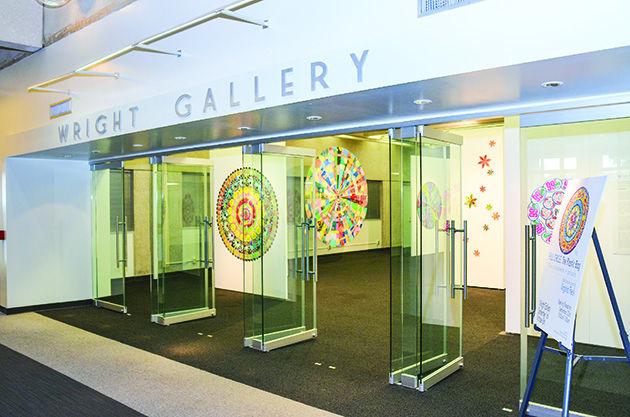Circular mandalas fill the Wright Gallery, offering an array of intricate patterns and colors.
Virginia Flecks’ circular mandalas transform the conventional views of plastic bags as objects of consumption into recyclable art.
Fleck attended two renowned art schools, the Portland School of Art and The School of Museum of Fine Arts in Boston. In 1990, shelved to Austin to work as a visual artist and since 2002 her work has been exclusively focused on recycled plastic bags.
Fleck said she used plastic bags in part because she has a history of using sound, physical objects and appreciates the inherent meaning of them.
“It stays with them when I use them as an artist,” Fleck said. “So in the case of plastic bags, that bag represents a purchase. You bought something and carried it home in that. I have a huge collection of bags at my studio. But it is also history of people buying items. So it is a history of consumerism.”
The idea of using plastic bags in the traditional mandalas was inspired by necessity, Fleck said.
“I was forced to think of something different,” Fleck said. “I was having a show in Cuba, and the parameter of the show was very limited. I had to bring something into Cuba myself in my suitcase and I wanted to be quite large.”
Karen Hillier, professor emerita of visualization, is actively involved in the exhibit work. Hiller said she was surprised by the amount of color Fleck’s work radiates, considering she used plastic bags as her medium.
“There is an unexpected depth within the use of color,” Hillier said. “I force myself to realize the color is composed of plastic bags, not delicate layers of water colors or glazes of oil paint.”
Hillier said she enjoys Fleck’s work and finds it soothing in a way.
“It invites the viewer to take delight in a contemplative process,” Hillier said. “The mandala-like organization of the imagery and the reliance on visual repetition offer comfort or an easiness when engaging with the image.”
When Fleck found the plastic bags were not only the mark of excessive consumerism but also about the environmental issues they posed, she said she started correlating these questions in her art.
“[The mandala] is very beautiful to look at, highly patterned and symmetrical,” Fleck said. “The imagery is quite different and would help you meditate. I am using some aspects of the traditional mandala, but using the bags gives my work a contemporary narrative.”
Fleck encourages visual artists to not be hindered by hardship as they go out into the world.
“It is difficult because you have to find your own way from scratch,” Fleck said. “But if you have to be an artist, then you have to be an artist.”
Felice House, visualization assistant professor, said Fleck asks accessible questions through her work, and in turn hopes to involve many students in the exhibit.
“It is my hope to integrate the students in the newly formed visualization MFA program with the gallery,” House said. “The artists that we are bringing in have a lot to offer these students in regards to professionalism and presentation. Networking is very important in the art world.”
The exhibit is open through Tuesday, at Wright Gallery on the second floor of the Langford A building.
A contemporary narrative’: mandalas crafted from bags
September 16, 2014
Jonathan Sheen — THE BATTALION
Virginia Fleck’s exhibit, housed in the Wright Gallery, will be on display through Tuesday.
0
Donate to The Battalion
$2790
$5000
Contributed
Our Goal
Your donation will support the student journalists of Texas A&M University - College Station. Your contribution will allow us to purchase equipment and cover our annual website hosting costs, in addition to paying freelance staffers for their work, travel costs for coverage and more!
More to Discover









